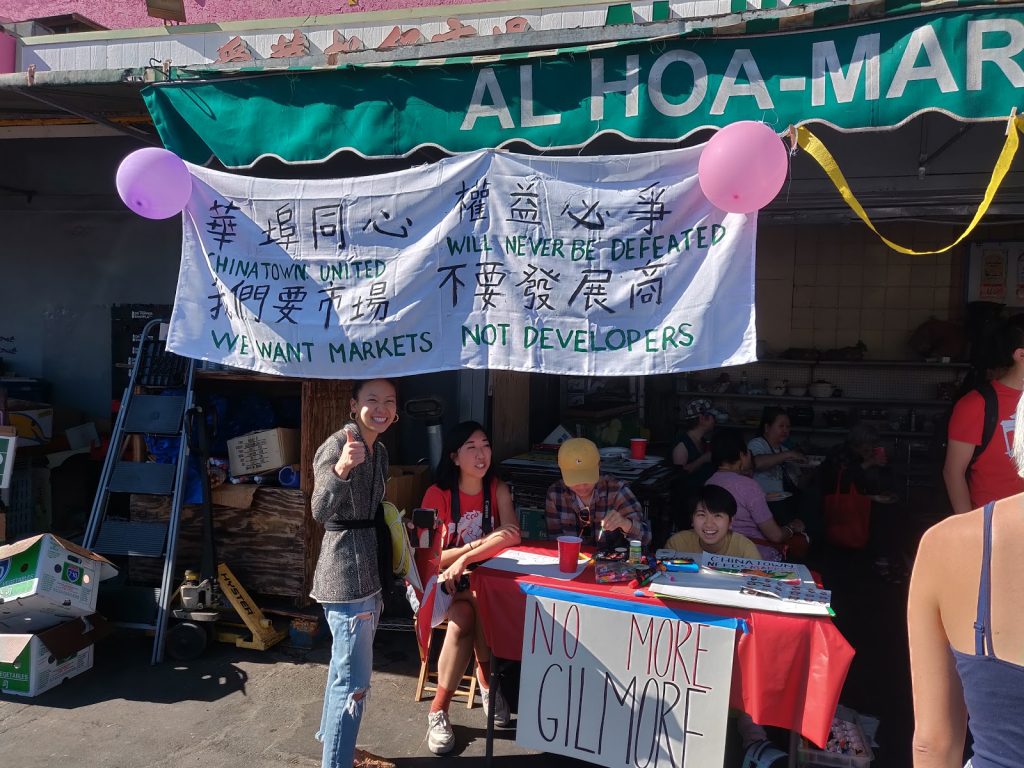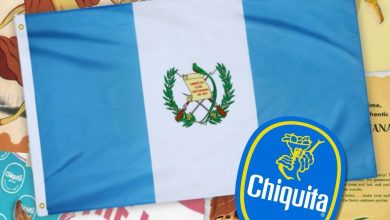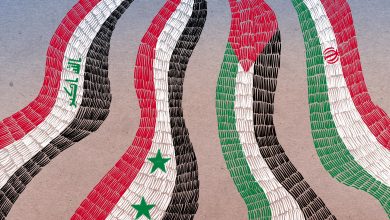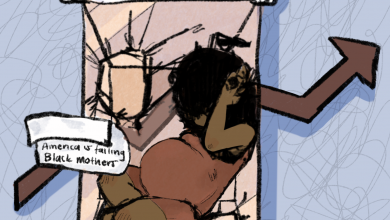Gentrification and Art-Washing Displace Ai Hoa Market

Photo by Rui Hua: Chinatown united will never be defeated! We want markets not developers! No More Gilmore! Banners and posters demanding more markets and the end of land developers in Chinatown. The people posing are organizers with @ccedla on Instagram, a collective that builds grassroots power with low-income and immigrant communities through organizing, education, and mutual help.
On Saturday, November 9th, Ai Hoa Market closed. This essential market served the Chinatown community for over 35 years and was the last full-service grocery store in Chinatown. The loss of this historic market will leave Chinatown in a food desert until another full-service grocery store can replace Ai Hoa. The low-income, mostly Vietnamese immigrant families and monolingual Cantonese-speaking elders living in Chinatown relied on Ai Hoa Market for access to fresh, affordable food, and even folks outside of Chinatown frequented the grocery store to buy items that couldn’t be found in Euro-American grocery chains.
Developers Tom Gilmore and Coco Kristal of the Gilmore China Group systematically drove out Ai Hoa Market with rent increases, lease changes, and parking price increases, causing the owners to lose $10,000 each month. Unable to afford the increasing financial burden, they were forced to move to South El Monte.
Unable to afford to stay, Ai Hoa tried to bring in a new business owner, but Gilmore refused to offer a long-term lease. Gilmore’s greed is driving out essential businesses and residents of the Chinatown community—-reportedly so he can build a luxury hotel in the middle of Chinatown.
Despite his exploitation and displacement of the Chinatown community, Gilmore is currently renting out a 11,500-square-foot space in downtown LA to the ArtCenter for only $1 a year. He obviously has the resources to keep rents affordable, but he intentionally increases rent and parking prices to displace vulnerable long-time residents for his own greedy, personal ends.
Tom Gilmore and Gilmore China Group’s actions are nothing short of class warfare. While long-time Chinatown residents fight rent increases and eviction, Gilmore actively participates in art-washing, which is a gentrifying tactic that uses art to socially erase areas of class struggle and displacement by making evicted neighborhoods palatable for wealthy people.
On October 18, Gilmore hosted “The Red Altar,” a Halloween-themed art show in Chinatown. Since the event occurred shortly after Ai Hoa owners announced the market’s closing, activists and organizers like @defendlachinatown on Instagram called for artists to boycott the event. The artists continued to show their art, and the event happened without incident.
Holding artists accountable for their complicity in the displacement of low-income, long-time residents is recognizing that lack of solidarity between artists and residents can only benefit wealthy land developers. It is important to note that most of the artists were young Asians and Asian-Americans, since this shows how people sharing ethnic and racial identities can still be complicit to gentrification. These artists legitimized the closing of Ai Hoa through art-washing and served to benefit land developers like Gilmore and George Yu.
As UCLA students, it is important to recognize that UCLA is a powerful gentrifier in LA— as the UC system is throughout the state. Especially in the art world, UCLA’s own professors are gentrifiers. For example, Distinguished Professor of New Genres in the Art Department, Barbara Kruger was seen speaking to a protestor only to then cross the picket line during an action protesting the artwashing of Boyle Heights that was organized by Boyle Heights Alliance Against Artwashing and Displacement (B.H.A.A.A.D.). This example is not unique within academia, as many UC professors and other members of the wealthy white art world who espouse ideas of community while enabling gentrification. While Chinatown and Boyle Heights are different areas in terms of location and demographics, both are neighborhoods in LA where art-washing is displacing vulnerable people to create playgrounds for the rich.
Some of the art studios that students frequent for parties and events may also contribute to art-washing. By following this boycott list, students can make sure that their presence is not legitimizing the displacement of residents and the gentrification of Chinatown. As consumers, we should resist apathy towards these important issues and strive to do all that we can to support the efforts of low-income residents in Los Angeles fighting for the basic rights of food and housing. As students of a prestigious university, we should amplify the calls and demands of vulnerable residents facing displacement and stand in solidarity with anti-gentrification activists.




